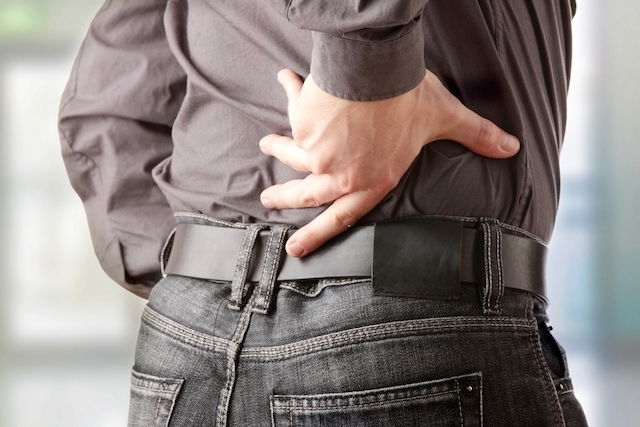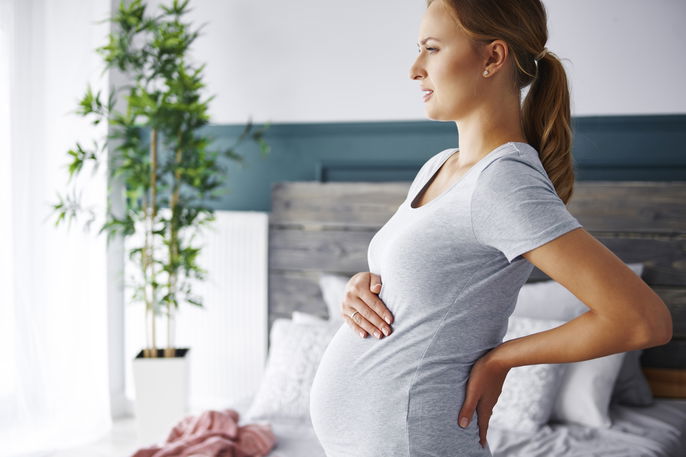The main causes of back pain include spinal problems, inflammation of the sciatic nerve or kidney stones. To differentiate between the different causes, you should monitor your symptoms for the type of pain you have and the region of the back that is affected.
Most cases of back pain are muscular in origin and occur due to fatigue, lifting weights or bad posture. These cases are easily remedies with warm compresses and stretching.
Nonetheless, if the pain emerges suddenly, if it is very intense, or if you have other associated symptoms like fever or difficulty moving, you should see your doctor for assessment and appropriate treatment if necessary.

What causes back pain?
The most common health conditions that lead to back pain include:
1. Poor posture
Poor posture when sleeping, walking, or even working, can cause intense pain in the lower back or upper back. It can also increase the risk of other spinal changes, such as scoliosis or torticollis.
What to do: you should make changes to your lifestyle, changing your posture when working, walking or even sleeping, opting for positions that better distribute body weight and relieve back pain. Additionally, exercises such as yoga or those recommended by the physiotherapist can be performed to improve posture.
2. Muscular injury
When your back pain is localized to the left or right side, it is normally a sign of a muscular injury. This can occur after physical activity, or as the result of activity from your job (as is the case with dentists or gardeners). Normally, this type of pain feels heavy and is very uncomfortable.
How to relieve it: To relieve pain associated with a muscle injury, you can place a warm compress on the affected area for 15 minutes, twice a day, for about 3 to 4 days. You can also apply a topical anti-inflammatory ointment, like diclofenac. In addition, when you are recovering, it is important to avoid heavy activity so that your symptoms can resolve quickly.
3. Respiratory illness
Respiratory illnesses can also cause back pain, mostly when you are breathing. The process of inhaling and exhaling requires the movement of all the muscles found in the back and abdomen.
How to relieve it: You are advised to see your doctor for treatment of the respiratory illness, especially if you experience symptoms like shortness of breath, coughing, phlegm or fever. In the meantime, you can place a warm compress in the affected area to relieve symptoms.
4. Kidney stones
The presence of kidney stones, or renal calculi, can also cause back pain. Pain that is caused by kidney stones is also called renal colic, and is characterized by intense pain felt in the lower back that affects walking or moving.
How to relieve it: In these cases, it is important to proceed to the emergency room for assessment and diagnosis. Through testing, the presence and size of kidney stones can be confirmed and appropriate treatment can be started. Treatment can involve medication to dissolve and eliminate the stones, as well as anti-inflammatories to relieve pain. The doctor may also opt to perform a small surgical procedure to remove the stones.
5. Sciatica
Sciatica is characterized by pain in the lower back that radiates to the legs. It is caused by compression of the sciatic nerve, which is found at the bottom of the spine, near the glutes. This type of pain is sharp and tingling and can result in difficulty with sitting or walking. Learn more about how to identify siatica and why it occurs.
How to relieve it: You are advised to see a doctor or orthopedic surgeon to confirm sciatic nerve compression, which can be done with MRI. He or she will indicate appropriate treatment, which may involve the use of medication and physiotherapy. See the 3 home remedies you can try to relieve sciatic nerve pain.
Complete our siatica symptoms quiz below to determine whether you pain is related to sciatic nerve inflammation:
6. Cardiac infarct
One of the signs of a heart attack, or cardiac infarct, is back pain with chest tightness that worsens when moving. You may also feel general malaise or nausea, or feel like you have a heavy weight on your chest. It is common to also have a health history of high blood pressure or high cholesterol.
How to relieve it: If you experience signs or symptoms of a heart attack, you should call for medical assistance immediately by dialing 911. First aid can be initiated immediately to avoid any further complications.
7. Herniated disc
A herniated disc can lead to pain in the middle of the back that worsens with standing or from prolonged positions. It is most common in people over the age of 45. This pain can also radiate to the side, to the ribs or down to the glutes or legs.
How to relieve it: You can place a warm compress on the affected area and avoid staying in the same position for too long. You are also advised to see a doctor or orthopedic surgeon for x-ray or MRI to visualize the hernia and to start appropriate treatment (which may include physiotherapy).
8. Muscle spasm
Muscle spasms can occur due to fatigue, excess physical activity, anxiety or bad posture. It usually results in pain in the upper back which, in some cases, can also be felt in the neck.
How to relieve it: Stretching exercises can greatly help to elongate muscles and relax them. Get into a comfortable position, and roll your head and neck slowly to the sides and to the front and back. This will help to relax upper back muscles.
9. Pregnancy

It is common for pregnant women to experience back pain, especially in the last months of pregnancy, due to spinal overload.
How to relieve it: To alleviate back pain during pregnancy, you should pursue massage therapy, perform exercises, and in some cases, participate in physiotherapy.
10. Shingles
Shingles is an infection caused by the chickenpox virus that causes red blisters to appear on the skin. They can appear in various parts of the body, including the mid back, causing tingling, burning sensations or pain.
What to do: Herpes zoster treatment must be carried out by a doctor who may recommend the use of antiviral medicines, such as acyclovir, famciclovir or valacyclovir, to reduce the multiplication of the virus and blisters on the skin.
Check out some home remedies for shingles that can help to speed-up recovery and reduce symptoms.
11. Arthritis
Arthritis is an inflammation of the joints that causes symptoms such as joint deformity, inflammation, stiffness or difficulty moving, which can affect various parts of the spine, making it difficult or limiting to carry out daily activities.
What to do: you should consult a rheumatologist to evaluate your symptoms and order lab tests and imaging to confirm the diagnosis. From here, the doctor can indicate the most appropriate treatment, which may involve analgesics, anti-inflammatory drugs or corticosteroids, or in some cases, surgery.
Learn about the arthritis diet that your doctor can recommend to help reduce symptoms and worsening.
12. Aortic aneurysm
An aortic aneurysm is a dilation of the walls of the aorta, which is located in the abdomen or chest. It generally does not cause symptoms, however when it increases in size it can lead to symptoms depending on its location, such as strong and intense pain in the chest, or pain felt on the side of the back.
What to do: The treatment for an aortic aneurysm varies according to its severity, location and the presence of other associated diseases. The doctor may recommend surgery to remove the part of the aorta that is damaged, and if necessary, the placement of a tube to replace the blood vessel.
13. Ankylosing spondylitis
Ankylosing spondylitis can cause back pain as it is characterized by an injury to the spine in the region where the vertebrae come together. It leads to symptoms such as difficulty in moving the spine and pain, which can worsen when the person is at rest and improve when lying down.
What to do: Treatment should be guided of an orthopedic surgeon who may recommend the use of analgesics, anti-inflammatories or muscle relaxants to relieve pain and improve joint mobility, in addition to physiotherapy, which is essential to increase flexibility, mobility, and quality of life.
When to see a doctor
You should consult a doctor when your back pain is very intense, if it occurs suddenly, or if you experience other symptoms like nausea or shortness of breath. The doctor can order testing to identify the cause, and from there, initiate appropriate treatment. He or she may recommend analgesics (like acetaminophen) or anti-inflammatories (like ibuprofen), or even surgery to correct spinal problems, like a herniated disc.
During the consult, it is important ot report the characteristics of your pain, when it started, if it hurts all the time or just with certain movements, and what you have done to try to relieve the pain. It may be helpful for your doctor to know what you do professional and whether you work in a sedentary job. Knowing these details can help the doctor reach a diagnosis more quickly and indicate the best treatment.
How to relieve back pain
To relieve back pain before a consult with your doctor, you can try the following:
- Rest: Lie on the floor or on a hard mattress every day for 30 minutes.
- Warm compresses: Place a warm compress with 3 drops of rosemary essential oil on the affected area for 15 minutes every day.
- Get a massage: with warm almond oil, without deep manipulation
- Homeopathy: take homeopathic medicine like arnica, as advised by a health care professional, to help with back inflammation
- Pilates exercise: these can help to strengthen back and abdominal muscles, to treat the cause of pain
In addition, you should also consider lifestyle changes like maintaining good posture or performing physical activity regularly (like weight training) which can also help to relieve pain.






























